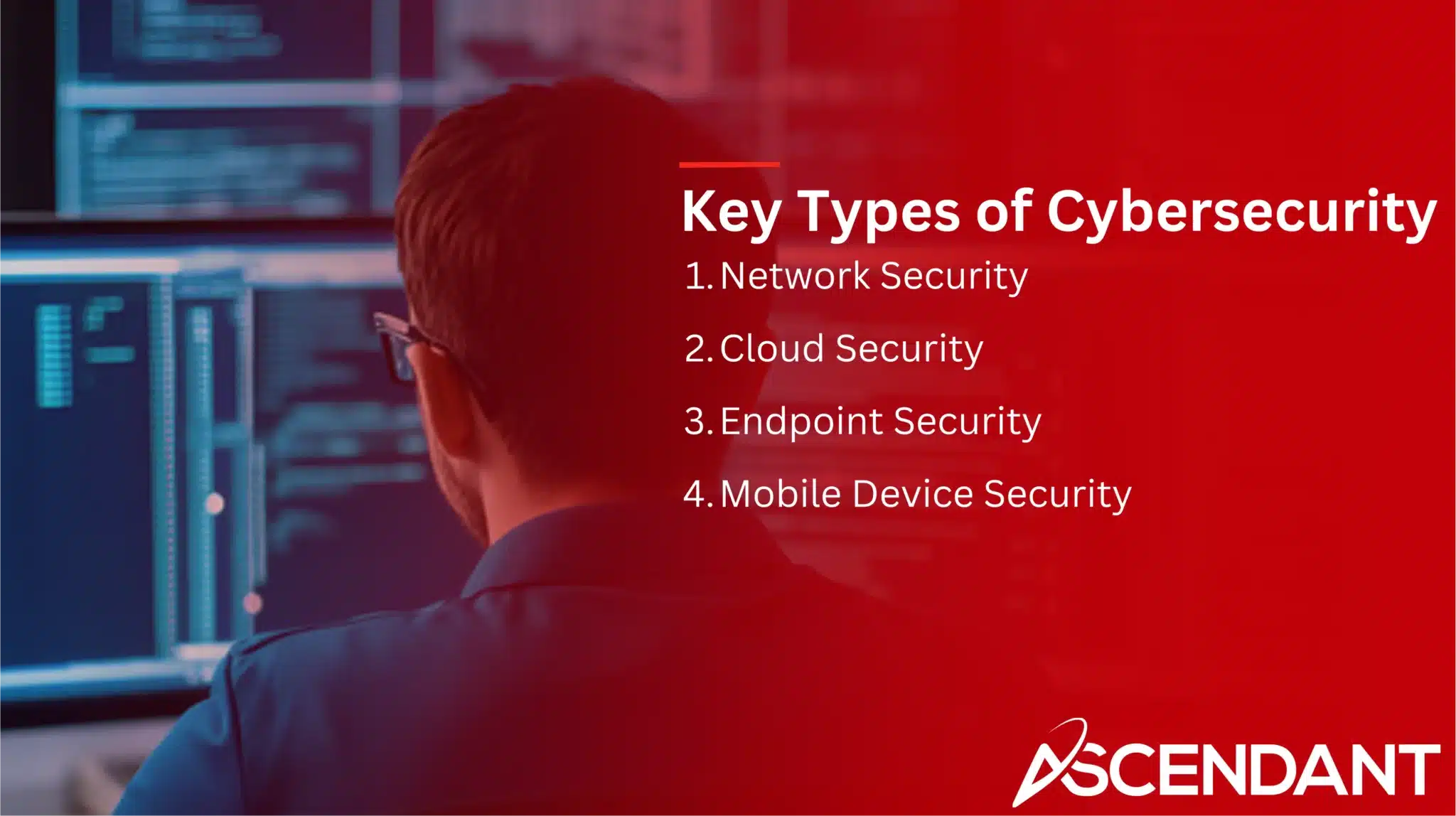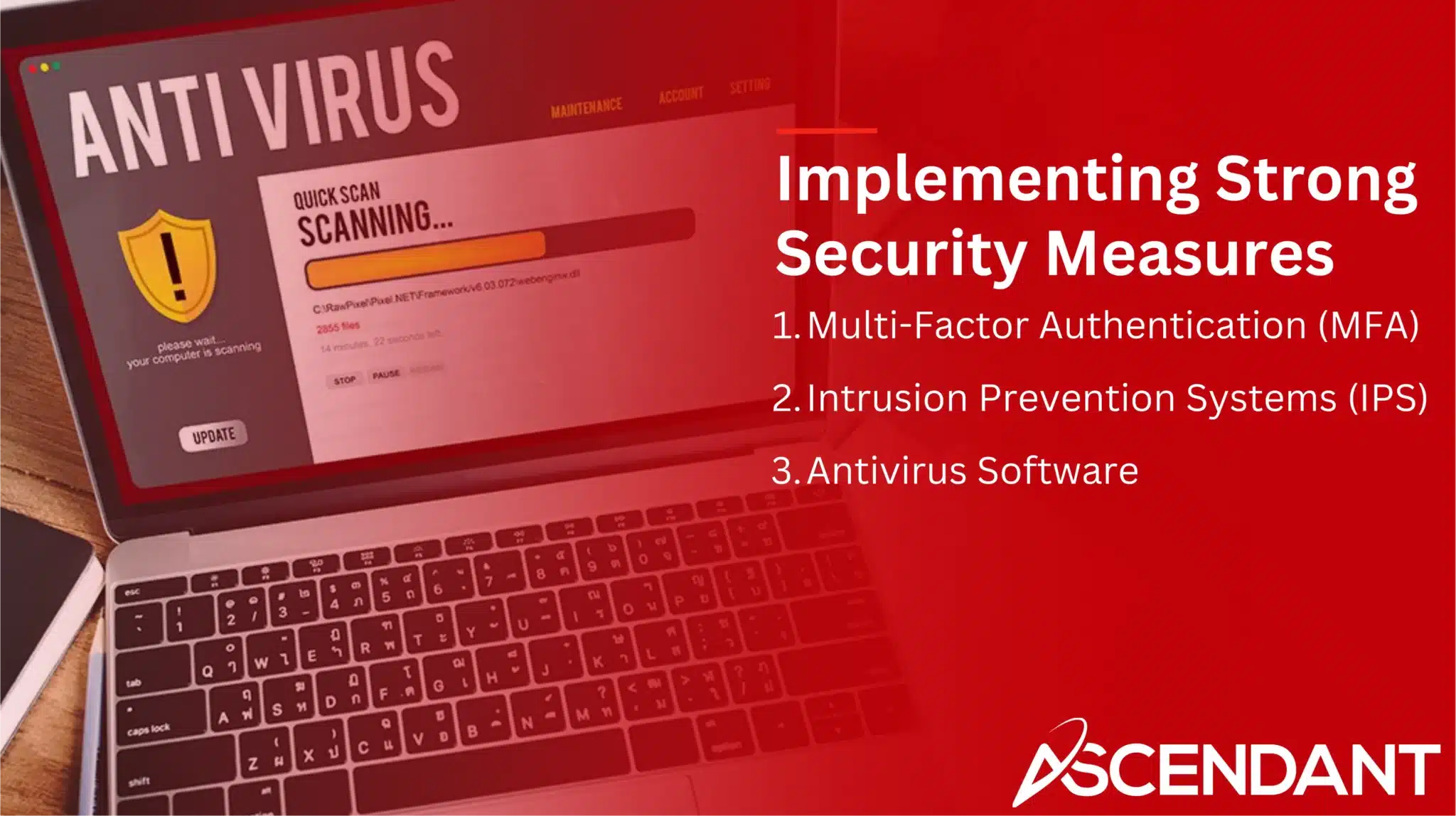Cybersecurity protects systems, networks, and data from digital attacks. These attacks aim to steal, modify, or destroy sensitive information. In this article, we will delve into key types of cybersecurity, the evolution of cyber threats, and the latest cybersecurity trends.
In This Article:
- Key Types of Cybersecurity
- The Evolution of Cyber Threats
- Cybersecurity Trends in 2025
- Importance of Cybersecurity Awareness
- Implementing Strong Security Measures
- Legal and Regulatory Considerations
- Role of Cyber Defenders
Key Takeaways
- Cybersecurity encompasses multiple key areas including network, cloud, endpoint, and mobile device security, each addressing specific vulnerabilities and employing distinct technologies.
- Emerging technologies such as AI and machine learning, alongside the adoption of Zero Trust Architecture, are shaping the future of cybersecurity, enhancing threat detection and response.
- Cybersecurity awareness and employee training are critical for preventing threats; effective incident response plans and compliance with regulations are vital for safeguarding sensitive information.
Key Types of Cybersecurity
Cybersecurity is an umbrella term that covers a range of disciplines designed to safeguard organizations against various cyber threats. Its primary objective is the protection of systems, networks, and programs from digital attacks such as data breaches, password theft, and other types of malicious activities. It achieves this by focusing on several critical aspects: network security, cloud security, endpoint security, and mobile device security.
These facets of cybersecurity are vital elements in an all-encompassing defense strategy rather than just abstract ideas. Each one tackles specific vulnerabilities by using different technologies and solutions for enhancing overall protection levels. A firm understanding and implementation of appropriate security measures within these areas can significantly diminish susceptibilities while strengthening defenses across multiple fronts against a plethora of cyber threats faced by organizations.
Network Security
Protecting computer systems from illicit entry and exploitation is central to any cybersecurity approach, epitomized by network security. To protect sensitive data and uphold the structural integrity of networks, strategies such as employing Data Loss Prevention techniques, managing identities through Access Management tools, controlling access via Network Control methods, and using advanced Firewalls are essential. Enhancing this protective shield can be achieved with network segmentation that divides different sectors of a system to curtail the spread of unauthorized infiltrations.
The crucial role played by robust network security defenses cannot be overstressed in an era marked by both frequent occurrences and evolving complexity of cyber-attacks. By instituting strong security measures focused on network protection, organizations can effectively confront potential digital threats while preserving the confidentiality, uprightness, and continuous availability of their critical infrastructure alongside ensuring secure access across their systems.
Cloud Security
In the wake of numerous organizations transitioning their operations to cloud-based platforms, the imperative for robust cloud security has been magnified. This type of security offers extensive defensive coverage against potential cyber threats at every possible point where an attack could occur, from safeguarding stored data to controlling who can access applications. An essential advantage provided by effective cloud security is its ability to swiftly pinpoint and rectify vulnerabilities that might be exploited if left unchecked.
The spectrum of tools used in bolstering cloud security includes encryption techniques, identity management systems, and stringent access control protocols—all aimed at shielding sensitive information from a myriad of cyber threats. By adopting vigorous cloud-specific security measures, organizations can reap the advantages offered by computing in the cloud while significantly reducing exposure to harmful incidents such as data breaches and diverse forms of cyber-attacks.
Endpoint Security
The security of endpoints, encompassing laptops, desktops, and mobile devices, is vital in shielding these units from malware and blocking access by unauthorized individuals. To defend these critical points within the network and bolster organizational security overall, sophisticated methods such as antivirus software and intrusion detection systems are utilized for advanced threat prevention.
As an increasing number of endpoints link to corporate networks, it becomes imperative to enhance endpoint security to minimize potential vulnerabilities that could lead to cyber-attacks. Implementing robust measures for endpoint protection is essential not only in securing crucial infrastructure but also in preserving the integrity of information systems.
Mobile Device Security
As mobile devices become more prevalent in work environments, it’s critical to defend them against cyber threats. This means ensuring the security of these devices from harmful software, deceptive phishing attempts, and various types of cyber-attacks that can put sensitive information at risk and hinder business functions.
Organizations must adopt robust security measures including multi-factor authentication and management systems for mobile devices to protect them effectively. By focusing on the security of mobile devices, organizations can strengthen their overall cybersecurity stance and address the distinct challenges posed by threats targeting mobility.
The Evolution of Cyber Threats
The realm of cyber threats has undergone significant changes, with those behind the attacks employing increasingly intricate and refined techniques. The array of security dangers posed to organizations is extensive, encompassing everything from basic viruses to complex ransomware and advanced persistent threats (APTs). These risks emanate from various sources including criminal syndicates, governmental entities, and lone operators who all play a role in this dynamic environment.
To combat the complexity of modern cyber-attacks effectively, organizations are advised to embrace Generation V cybersecurity solutions. Such an approach demands a thorough comprehension of emerging security challenges while instituting stringent protective measures. It also necessitates ongoing vigilance involving perpetual surveillance as well as regular updates to defense strategies in order to remain one step ahead of prospective adversaries.
Advanced Persistent Threats (APTs)
APTs represent prolonged and covert operations designed to pilfer confidential information from specific entities, with such complex cyber assaults frequently remaining undiscovered over long durations. This presents a substantial danger to the security of organizations. To bolster cybersecurity barriers and protect classified data, it’s essential to grasp the nature of APTs.
These aggressive campaigns usually employ various methods of infiltration and are executed by adept adversaries. In response, organizations need to establish wide-ranging protective strategies that incorporate intrusion prevention systems, sophisticated threat identification capabilities, and relentless surveillance in order to mitigate these multifaceted threats.
Ransomware Attacks
In recent times, ransomware attacks have risen to become one of the most common and harmful types of cyber-attacks. These incidents encrypt an organization’s data and demand payment in exchange for restoring access to it. The economic consequences of these ransomware events are considerable, as the average incident costs approximately $1.85 million.
Even if faced with paying a ransom, there is no assurance that this will result in retrieving the encrypted files. As such, organizations should prioritize preventative measures and strategies aimed at reducing risk. This includes consistently backing up data, implementing strong antivirus software programs, and educating staff on how to identify phishing emails that could lead to breaches.
Social Engineering
Social engineering attacks exploit human psychology to deceive individuals into divulging sensitive information or performing actions that compromise security to gain access. Phishing is a common tactic within social engineering, where attackers send fraudulent emails to steal sensitive data. These attacks can be conducted through various channels, including email, text messages, social media, and websites.
To defend against social engineering attacks, organizations must focus on:
- Cybersecurity awareness and training, ensuring that employees can recognize and respond to potential threats.
- Implementing strong security controls.
- Monitoring for suspicious activities to help mitigate the risks associated with social engineering.
Cybersecurity Trends in 2025
Heading into 2025, the advancement of technologies such as artificial intelligence, machine learning, and the Internet of Things (IoT) is transforming the cybersecurity field. While these developments present new avenues to bolster security measures, they also bring about fresh vulnerabilities. It’s crucial for organizations to keep up with these changes in order to safeguard their digital assets effectively.
Among the notable cybersecurity trends in this year are embracing Zero Trust Architecture strategies, leveraging AI and machine learning to identify threats more efficiently, and placing greater emphasis on securing IoT devices against breaches. By understanding and integrating these cutting-edge approaches within their operations, organizations can stay one step ahead of emerging threats and enhance their defense mechanisms against cyber-attacks.
Zero Trust Architecture
The Zero Trust Architecture approach to security advocates for stringent access controls and the constant authentication of authorized users. Implementing this architecture relies on key mechanisms such as multi-factor authentication, evaluating the condition of devices accessing the system, and dividing networks into separate segments. This method enhances safety by treating all users and devices with a default level of distrust.
To integrate Zero Trust Architecture within an organization’s existing security measures requires thorough analysis of business activities, potential risks involved, and specific objectives regarding security. When organizations embrace this strategy, they strengthen their defensive stance against threats through more robust protection methods.
AI and Machine Learning
Cybersecurity is being transformed by artificial intelligence (AI) and machine learning, which are streamlining the automation of responses to cyber threats while accelerating the detection process. By scrutinizing vast amounts of data for irregular patterns that may signify looming threats, these algorithms enhance security measures by shortening reaction times.
The adoption of emerging technologies enables quicker identification of anomalies when compared to conventional approaches. The integration of AI and machine learning not only bolsters threat intelligence but also automates protective actions, thereby diminishing delay in responses and strengthening the overall stance against cybersecurity threats.
IoT Devices Security
As IoT devices become increasingly widespread, they bring with them substantial security challenges by potentially acting as gateways for cyber-attacks. To secure these devices, it is crucial to tackle vulnerabilities within the entire network of connected gadgets in order to block any unauthorized access.
To fortify their defenses against such threats, organizations are compelled to adopt strong security measures which include encryption and persistent monitoring of their systems. By placing a high emphasis on securing IoT devices, these entities can reduce risks and substantially strengthen their cybersecurity stance.
Importance of Cybersecurity Awareness
Raising awareness about cybersecurity equips both individuals and entities with the necessary tools to recognize and address potential cyber threats. By keeping abreast of emerging trends in cybersecurity and adhering to recommended best practices, the likelihood of falling victim to cyber-attacks can be greatly diminished. The Cybersecurity and Infrastructure Security Agency (CISA) offers a wealth of information on its website for those looking to strengthen their knowledge.
The repercussions of cybercrime are far-reaching, potentially leading to incidents like identity theft, blackmail, or significant data breaches. Fostering an environment where cybersecurity consciousness is prioritized not only bolsters one’s own defenses, but also safeguards critical infrastructure along with confidential data against unauthorized access or harm.
Employee Training
Fostering a robust cybersecurity environment within an organization hinge on educating employees. It’s essential for staff to grasp basic security measures, including the creation of strong passwords, exercising vigilance with email attachments, and consistently backing up critical data to thwart cyber threats. As social engineering attacks target human behavior in order to extract sensitive information, it becomes crucial for awareness and educational initiatives.
The introduction of multi-factor authentication (MFA) has been instrumental in diminishing the likelihood of unauthorized access since it necessitates several forms of verification aside from merely relying on passwords. Continual education sessions are paramount for employees to recognize the significance of MFA alongside other fundamental cybersecurity best practices.
Incident Response Plans
Organizations can respond to cyber threats quickly and effectively when they have a well-defined incident response plan in place. This plan should clearly define the roles and responsibilities of each team member so that there is no confusion about who needs to do what during a cyber-attack.
To maintain their effectiveness against changing threats, it’s crucial for organizations to frequently test and revise their incident response plans. A robust plan not only helps reduce the damage caused by cyber-attacks, but also facilitates rapid restoration from any disturbances they cause.
Public Education
Educating the public is crucial for improving cybersecurity awareness and mitigating risks. Collaborative efforts between organizations and the federal government aim to raise awareness about cyber threats and protective strategies. Employees benefit from ongoing training that teaches them best practices, how to create strong passwords, and ways to recognize malicious emails.
Continual education helps keep up with proper cybersecurity hygiene while tackling new threats as they arise. By raising awareness and offering tools, both individuals and organizations are better equipped to proactively secure their digital assets against potential breaches.
Implementing Strong Security Measures
Robust security measures are essential to safeguard systems, networks, and data against cyber threats. To counteract diverse threats effectively, cybersecurity must employ a multi-layered approach of protection. Crucial components like firewalls and intrusion prevention systems (IPS) play an integral role within network security solutions by detecting and preventing attacks that typically take place across network channels.
Equally important is endpoint security, which ensures the defense of individual devices from malicious software as well as unauthorized entry. Integrating comprehensive security solutions into a formidable security architecture can significantly reduce vulnerabilities while strengthening the overall cybersecurity stance.
Multi-Factor Authentication (MFA)
Multi-Factor Authentication (MFA) enhances modern security measures by necessitating that various verification methods be employed before allowing access to a system. This approach is particularly vital within Zero Trust Architecture, which advocates for stringent management of access and the ongoing validation of users who are authorized, in an effort to mitigate potential risks.
By conducting frequent training sessions, employees can become well-versed in MFA best practices and improve their ability to recognize possible security threats. The adoption of MFA plays a significant role in curtailing the likelihood of unauthorized entry and strengthens the general stance on security.
Intrusion Prevention Systems (IPS)
Intrusion Prevention Systems (IPS) are essential tools in real-time detection and mitigation of cyber threats. By actively scrutinizing network traffic, IPS technologies thwart potential dangers before damage can be done. They utilize multiple detection techniques including signature-based identification and statistical anomaly analysis to detect malicious behavior.
Contrary to intrusion detection systems (IDS), which merely notify administrators of unusual activities, IPS have the capability to autonomously react by recording information on suspicious actions and executing pre-established countermeasures. The deployment of IPS strengthens cyber defense mechanisms, providing vital protection for critical infrastructure against a landscape of advancing threats.
Antivirus Software
Antivirus software serves as an essential protective barrier against cyber threats, critical in detecting and eradicating detrimental software that could undermine the integrity of an operating system. These programs continuously scrutinize computer systems to locate and expunge a plethora of malware types, thereby protecting them from malicious code.
By effectively purging malware, antivirus software is pivotal in bolstering protection from cyber threats and strengthening overall security measures. The deployment of steadfast antivirus solutions stands as a fundamental element within an all-encompassing cybersecurity strategy.
Legal and Regulatory Considerations
Cybersecurity involves a crucial obligation to understand and abide by legal and regulatory frameworks. Protecting sensitive data entails deploying various strategies such as encryption, endpoint security measures, and the physical safeguarding of information. This is pivotal in ensuring both government secrets and consumer data are secure amidst growing concerns from governments and business sectors.
Ensuring adherence to regulations not only secures confidential information, but also helps circumvent potential legal consequences. Keeping abreast with legislative mandates while fortifying security protocols strengthens defenses against informational vulnerabilities, thereby bolstering overall information security efforts.
Global Regulations
Working together with nations worldwide is essential in the fight against global cybercrime, and agreements such as the Budapest Convention are designed to bolster international partnerships for better cybersecurity measures. Sharing intelligence internationally is a critical element in crafting well-rounded approaches to combat universal cyber threats.
Staying connected with foreign allies helps organizations stay abreast of emerging cyber threats and superior methods of defense, strengthening their safeguards against potential cyber attacks. It’s imperative that entities comprehend international guidelines and engage actively in worldwide collaboration to preserve robust defenses against these pervasive security challenges.
Compliance Requirements
Organizations in sectors like healthcare and finance are subject to stringent compliance requirements that dictate specific cybersecurity practices. Regulations such as HIPAA in the healthcare sector mandate the protection of patient data, while PCI DSS in the financial sector ensures the security of payment card information.
Adhering to these compliance standards is essential for protecting sensitive data and avoiding legal penalties. Implementing robust security measures and staying informed about industry regulations ensures compliance and enhances cybersecurity posture.
Data Protection Laws
Legislation such as the General Data Protection Regulation (GDPR) in Europe and the California Consumer Privacy Act (CCPA) in the United States grants individuals authority over their own personal data. These laws require organizations to establish strong safeguards for data protection and to secure clear permission from persons before gathering their personal information.
The stringent criteria established by GDPR, CCPA, and similar regulations dictate careful management of personal data to prevent breaches. Adherence to these laws secures sensitive information, bolsters trust among consumers, and prevents legal penalties for non-compliance.
Role of Cyber Defenders
Professionals dedicated to cyber defense play a vital role in shielding organizations from various online dangers. These individuals undertake an array of tasks, including analyzing threats and securing systems, which demands a blend of technical acumen and inventive problem-solving capabilities. Their diligent actions are crucial in defending computer systems and confidential data against the continuous emergence of cyber threats.
Working together with both global allies and stakeholders within the private sector significantly bolsters defenses against cybersecurity challenges. This cooperative environment among those specializing in cyber defense leads to groundbreaking approaches, collective adoption of superior methods, and all-encompassing tactics for addressing worldwide cyber offenses.
Cybersecurity Professionals
Cybersecurity professionals handle various roles, from managing all security tasks in small firms to overseeing dedicated departments in larger companies. Common tasks include analyzing threats and gathering information from servers, cloud services, and devices. A degree in cybersecurity and certifications, such as the Certified Information Systems Security Professional (CISSP), are often sought after by employers.
The growing demand for cybersecurity professionals across all business sectors highlights the importance of these roles. With a willingness to learn and the right qualifications, individuals can find diverse opportunities in cybersecurity and contribute significantly to protecting organizations from cyber threats.
Collaboration with International Partners
Collaboration with international partners is crucial for staying up to date on the latest threats and best practices in cybersecurity. Such partnerships strengthen an organization’s defenses against cyber attacks by providing insights into a constantly shifting threat landscape.
Working together at a global level through intelligence sharing and strategy development is key to combating worldwide cybercrime effectively. International laws and agreements set the groundwork for this cooperation, improving collective cybersecurity efforts across different countries.
Private Sector Contributions
Organizations within the private sector are essential in crafting the innovative responses necessary to address the continuously changing landscape of cyber threats. Their efforts typically encompass pioneering technologies, robust security protocols, and considerable financial commitments towards bolstering cybersecurity defenses.
By exchanging best practices, establishing alliances, and engaging in unified groups, companies from the private sector significantly boost collective security resilience. This collaborative approach markedly elevates the efficiency and durability of cybersecurity strategies on a wide scale.
Summary
In summary, cybersecurity is a multifaceted and ever-evolving field that requires continuous vigilance and robust security measures. Understanding the key types of cybersecurity, the evolution of cyber threats, and current trends is essential for protecting digital assets. Implementing strong security measures, raising cybersecurity awareness, and complying with legal and regulatory requirements are critical steps in safeguarding sensitive information.
By working together, cybersecurity professionals, international partners, and the private sector can develop innovative solutions and share best practices to combat global cybercrime. As we move forward, staying informed and proactive will be key to enhancing cybersecurity and protecting our digital future.
 Frequently Asked Questions
Frequently Asked Questions
What is cybersecurity in simple words?
Cybersecurity is the practice of safeguarding systems, networks, and data from digital attacks that aim to compromise or destroy sensitive information. It encompasses various technologies, processes, and controls designed to defend against these threats.
Is a 2-year cyber security degree worth it?
A 2-year cybersecurity degree is indeed worth it, as it opens the door to entry-level positions in a growing field with competitive salaries and lays the foundation for further education and certifications.
This qualification can significantly enhance your marketability and job prospects in technology.
Does cybersecurity really pay well?
Cybersecurity does pay well, with an average annual salary of $124,740 for analysts, making it one of the top professions in terms of compensation and growth potential. This lucrative salary reflects its high demand and importance in today’s job market.
What are the key types of cybersecurity?
The key types of cybersecurity are network security, cloud security, endpoint security, and mobile device security, each targeting specific vulnerabilities with tailored technologies and solutions for effective protection.
Understanding these areas is essential for establishing a comprehensive cybersecurity strategy.
How have cyber threats evolved over the years?
Cyber threats have significantly evolved from basic viruses to sophisticated attacks such as advanced persistent threats (APTs), ransomware, and social engineering tactics. This transformation has been driven by the involvement of criminal organizations, state actors, and individual hackers.



